Dynamic Mechanism of Destination Brand Diffusion: Agent-Based Modeling and Simulation
Abstract
:1. Introduction
- RQ1: How do destination hot events diffuse on social media?
- RQ2: What is the influence of infected rates of communicators at different stages?
2. Literature Review
2.1. Destination Brand
2.2. Destination Brand Diffusion
2.3. Information Dissemination Model
3. Method and Data
3.1. Method
3.2. Data
4. Model Description
5. Simulation and Results
5.1. Parameter Settings
5.1.1. Impact of Changes in Infection Rate
5.1.2. Impact of Changes in Dissemination Rate
5.1.3. Impact of Changes in Removing Rates
5.1.4. Impact of Changes in Secondary Infection Rate
5.1.5. User’s Adoption Rate
5.1.6. Dissemination and Recovering Rate
5.2. Comparison with the Actual Event
6. Conclusions
6.1. Theoretical Contributions
6.2. Managerial Implications
6.3. Limitations and Future Research Directions
Author Contributions
Funding
Data Availability Statement
Conflicts of Interest
References
- Petrosyan, A. Number of Internet and Social Media Users Worldwide as of October 2023. Available online: https://www.statista.com/statistics/617136/digital-population-worldwide/ (accessed on 1 December 2023).
- Ortiz-Ospina, E. The Rise of Social Media. Available online: https://ourworldindata.org/rise-of-social-media (accessed on 1 December 2023).
- Ananda, A.S.; Hernández-García, Á.; Lamberti, L. N-REL: A Comprehensive Framework of Social Media Marketing Strategic Actions for Marketing Organizations. J. Innov. Knowl. 2016, 1, 170–180. [Google Scholar] [CrossRef]
- Wang, H.; Yan, J. Effects of Social Media Tourism Information Quality on Destination Travel Intention: Mediation Effect of Self-Congruity and Trust. Front. Psychol. 2022, 13, 1049149. [Google Scholar] [CrossRef] [PubMed]
- Thomas, H. Social Media Has the Greatest Influence on Travel Destination Choices. Available online: https://www.statista.com/chart/30135/media-influences-on-travel-destination/ (accessed on 1 December 2023).
- Pike, S.; Page, S.J. Destination Marketing Organizations and Destination Marketing: A Narrative Analysis of the Literature. Tour. Manag. 2014, 41, 202–227. [Google Scholar] [CrossRef]
- Huang, G.I.; Karl, M.; Wong, I.A.; Law, R. Tourism Destination Research from 2000 to 2020: A Systematic Narrative Review in Conjunction with Bibliographic Mapping Analysis. Tour. Manag. 2023, 95, 104686. [Google Scholar] [CrossRef]
- Benckendorff, P.; Zehrer, A. A Network Analysis of Tourism Research. Ann. Tour. Res. 2013, 43, 121–149. [Google Scholar] [CrossRef]
- Wong, I.A.; Song, Y.C.; Zhang, C. Not All Films Are Created the Same: Understanding the Cross-Level Effect of Movie Ratings on Destination Image Creation. J. Travel Tour. Mark. 2021, 38, 356–367. [Google Scholar] [CrossRef]
- Chekalina, T.; Fuchs, M.; Lexhagen, M. Customer-Based Destination Brand Equity Modeling: The Role of Destination Resources, Value for Money, and Value in Use. J. Travel Res. 2018, 57, 31–51. [Google Scholar] [CrossRef]
- Luo, Q.; Zhai, X. “I Will Never Go to Hong Kong Again!” How the Secondary Crisis Communication of “Occupy Central” on Weibo Shifted to a Tourism Boycott. Tour. Manag. 2017, 62, 159–172. [Google Scholar] [CrossRef] [PubMed]
- Barreda, A.A.; Nusair, K.; Wang, Y.; Okumus, F.; Bilgihan, A. The Impact of Social Media Activities on Brand Image and Emotional Attachment: A Case in the Travel Context. J. Hosp. Tour. Technol. 2020, 11, 109–135. [Google Scholar] [CrossRef]
- Morgan, N.; Pritchard, A.; Pride, R. Tourism Places, Brands, and Reputation Management. In Destination Brands, 3rd ed.; Morgan, N., Pritchard, A., Pride, R., Eds.; Butterworth-Heinemann: Oxford, UK, 2011; pp. 3–19. ISBN 978-0-08-096930-5. [Google Scholar]
- Zenker, S.; Braun, E. Branding a City: A Conceptual Approach for Place Branding and Place Brand Management. In Proceedings of the 39th EMAC Annual Conference, Frederiksberg, Denmark, 1–4 June 2010. [Google Scholar]
- Blain, C.; Levy, S.E.; Ritchie, J.B. Destination Branding: Insights and Practices from Destination Management Organizations. J. Travel Res. 2005, 43, 328–338. [Google Scholar] [CrossRef]
- Lee, G.; O’Leary, J.T.; Hong, G.S. Visiting Propensity Predicted by Destination Image: German Long-Haul Pleasure Travelers to the US. Int. J. Hosp. Tour. Adm. 2002, 3, 63–92. [Google Scholar] [CrossRef]
- Ritchie, J.; Ritchie, J. The Branding of Tourism Destinations. In Proceedings of the Annual Congress of the International Association of Scientific Experts in Tourism, Marrakech, Morocco, September 1998. Available online: https://citeseerx.ist.psu.edu/document?repid=rep1&type=pdf&doi=f04795dd595c0aeb22bf202f6626caac80987644 (accessed on 1 December 2023).
- Kotsi, F.; Pike, S. Destination Brand Positioning Theme Development Based on Consumers’ Personal Values. J. Hosp. Tour. Res. 2021, 45, 573–587. [Google Scholar] [CrossRef]
- Hankinson, G. Relational Network Brands: Towards a Conceptual Model of Place Brands. J. Vacat. Mark. 2004, 10, 109–121. [Google Scholar] [CrossRef]
- Seyyedamiri, N.; Khosravani, A. Identification of the Effective E-Promotional Tools on Improving Destination Brand Image. J. Glob. Inf. Manag. JGIM 2020, 28, 169–183. [Google Scholar] [CrossRef]
- Andéhn, M.; Kazeminia, A.; Lucarelli, A.; Sevin, E. User-Generated Place Brand Equity on Twitter: The Dynamics of Brand Associations in Social Media. Place Brand. Public Dipl. 2014, 10, 132–144. [Google Scholar] [CrossRef]
- Edwards, D.; Cheng, M.; Wong, I.A.; Zhang, J.; Wu, Q. Ambassadors of Knowledge Sharing: Co-Produced Travel Information through Tourist-Local Social Media Exchange. Int. J. Contemp. Hosp. Manag. 2017, 29, 690–708. [Google Scholar] [CrossRef]
- Bazzanella, F.; Bichler, B.F.; Schnitzer, M. Collaboration and Meta-Organisation in Event Tourism–Effects of the Olympic Agenda 2020 on Planning the 2026 Winter Olympics. Tour. Manag. Perspect. 2022, 41, 100939. [Google Scholar] [CrossRef]
- Shao, J.; Li, X.; Morrison, A.M.; Wu, B. Social Media Micro-Film Marketing by Chinese Destinations: The Case of Shaoxing. Tour. Manag. 2016, 54, 439–451. [Google Scholar] [CrossRef]
- Williams, N.L.; Inversini, A.; Ferdinand, N.; Buhalis, D. Destination eWOM: A Macro and Meso Network Approach? Ann. Tour. Res. 2017, 64, 87–101. [Google Scholar] [CrossRef]
- Wong, C.U.I.; Qi, S. Tracking the Evolution of a Destination’s Image by Text-Mining Online Reviews-the Case of Macau. Tour. Manag. Perspect. 2017, 23, 19–29. [Google Scholar] [CrossRef]
- Wang, Z.; Liu, W.; Sun, Z.; Zhao, H. Understanding the World Heritage Sites’ Brand Diffusion and Formation via Social Media: A Mixed-Method Study. Int. J. Contemp. Hosp. Manag. 2023, 36, 602–631. [Google Scholar] [CrossRef]
- Horowitz, D.M. The New Community Rules: Marketing on the Social Web. J. Prod. Brand Manag. 2010, 19, 461–463. [Google Scholar] [CrossRef]
- Zhou, X.; Liang, W.; Luo, Z.; Pan, Y. Periodic-Aware Intelligent Prediction Model for Information Diffusion in Social Networks. IEEE Trans. Netw. Sci. Eng. 2021, 8, 894–904. [Google Scholar] [CrossRef]
- Zhou, X.; Liang, W.; Wang, K.I.-K.; Huang, R.; Jin, Q. Academic Influence Aware and Multidimensional Network Analysis for Research Collaboration Navigation Based on Scholarly Big Data. IEEE Trans. Emerg. Top. Comput. 2021, 9, 246–257. [Google Scholar] [CrossRef]
- He, Z.; Cai, Z.; Yu, J. Latent-Data Privacy Preserving with Customized Data Utility for Social Network Data. IEEE Trans. Veh. Technol. 2018, 67, 665–673. [Google Scholar] [CrossRef]
- Dong, S.; Deng, Y.-B.; Huang, Y.-C. SEIR Model of Rumor Spreading in Online Social Network with Varying Total Population Size. Commun. Theor. Phys. 2017, 68, 545. [Google Scholar] [CrossRef]
- Li, M.; Wang, X.; Gao, K.; Zhang, S. A Survey on Information Diffusion in Online Social Networks: Models and Methods. Information 2017, 8, 118. [Google Scholar] [CrossRef]
- Zhao, Y.; Kou, G.; Peng, Y.; Chen, Y. Understanding Influence Power of Opinion Leaders in E-Commerce Networks: An Opinion Dynamics Theory Perspective. Inf. Sci. 2018, 426, 131–147. [Google Scholar] [CrossRef]
- Ben-Naim, E.; Krapivsky, P. Scaling Behavior of Threshold Epidemics. Eur. Phys. J. B 2012, 85, 145. [Google Scholar] [CrossRef]
- Hethcote, H.W.; van den Driessche, P. Some Epidemiological Models with Nonlinear Incidence. J. Math. Biol. 1991, 29, 271–287. [Google Scholar] [CrossRef] [PubMed]
- Kermack, W.O.; McKendrick, A.G. A Contribution to the Mathematical Theory of Epidemics. Proc. R. Soc. London. Ser. A Contain. Pap. A Math. Phys. Character 1927, 115, 700–721. [Google Scholar]
- Goffman, W.; Newill, V. A Generalization of Epidemic Theory: An Application to the Transmission of Ideas. Nature 1964, 204, 225–228. [Google Scholar] [CrossRef] [PubMed]
- Anderson, R.M.; May, R.M. Infectious Diseases of Humans: Dynamics and Control; Oxford University Press: Oxford, UK, 1991. [Google Scholar]
- Garas, A.; Argyrakis, P.; Rozenblat, C.; Tomassini, M.; Havlin, S. Worldwide Spreading of Economic Crisis. N. J. Phys. 2010, 12, 113043. [Google Scholar] [CrossRef]
- Wang, H.; Deng, L.; Xie, F.; Xu, H.; Han, J. A New Rumor Propagation Model on SNS Structure. In Proceedings of the 2012 IEEE International Conference on Granular Computing, Hangzhou, China, 11–13 August 2012; pp. 499–503. [Google Scholar]
- Wang, Y.; Cao, J.; Alsaedi, A.; Ahmad, B. Edge-Based SEIR Dynamics with or without Infectious Force in Latent Period on Random Networks. Commun. Nonlinear Sci. Numer. Simul. 2017, 45, 35–54. [Google Scholar] [CrossRef]
- Zhao, L.; Yuan, R.; Guan, X.; Li, M. Propagation Modeling and Analysis of Incidental Topics in Blogosphere. In Proceedings of the Online Communities and Social Computing: Third International Conference, OCSC 2009, Held as Part of HCI International 2009, San Diego, CA, USA, 19–24 July 2009; Proceedings 3. Springer: Berlin/Heidelberg, Germany, 2009; pp. 401–410. [Google Scholar]
- Jiang, P.; Yan, X. A Quantitative Model for the Spread of Online Information. Qual. Quant. 2019, 53, 1981–2001. [Google Scholar] [CrossRef]
- Xie, T.; Wei, Y.; Chen, W.; Huang, H. Parallel Evolution and Response Decision Method for Public Sentiment Based on System Dynamics. Eur. J. Oper. Res. 2020, 287, 1131–1148. [Google Scholar] [CrossRef] [PubMed]
- Li, Q.; Du, Y.; Li, Z.; Hu, J.; Hu, R.; Lv, B.; Jia, P. HK–SEIR Model of Public Opinion Evolution Based on Communication Factors. Eng. Appl. Artif. Intell. 2021, 100, 104192. [Google Scholar] [CrossRef]
- Chen, T.; Rong, J.; Yang, J.; Cong, G. Modeling Rumor Diffusion Process with the Consideration of Individual Heterogeneity: Take the Imported Food Safety Issue as an Example during the COVID-19 Pandemic. Front. Public Health 2022, 10, 781691. [Google Scholar] [CrossRef] [PubMed]
- Fang, B.; Jia, Y.; Han, Y.; Li, S.; Zhou, B. A Survey of Social Network and Information Dissemination Analysis. Chin. Sci. Bull. 2014, 59, 4163–4172. [Google Scholar] [CrossRef]
- Tian, C.; Xiao, T.; Shang, J. Channel Differentiation Strategy in a Dual-Channel Supply Chain Considering Free Riding Behavior. Eur. J. Oper. Res. 2022, 301, 473–485. [Google Scholar] [CrossRef]
- Railsback, S.F.; Grimm, V. Agent-Based and Individual-Based Modeling: A Practical Introduction; Princeton University Press: Princeton, NJ, USA, 2019. [Google Scholar]
- Koponen, I.T. Agent-Based Modeling of Consensus Group Formation with Complex Webs of Beliefs. Systems 2022, 10, 212. [Google Scholar] [CrossRef]
- Zhang, M.; Qin, S.; Zhu, X. Information Diffusion under Public Crisis in BA Scale-Free Network Based on SEIR Model—Taking COVID-19 as an Example. Phys. A Stat. Mech. Its Appl. 2021, 571, 125848. [Google Scholar] [CrossRef]


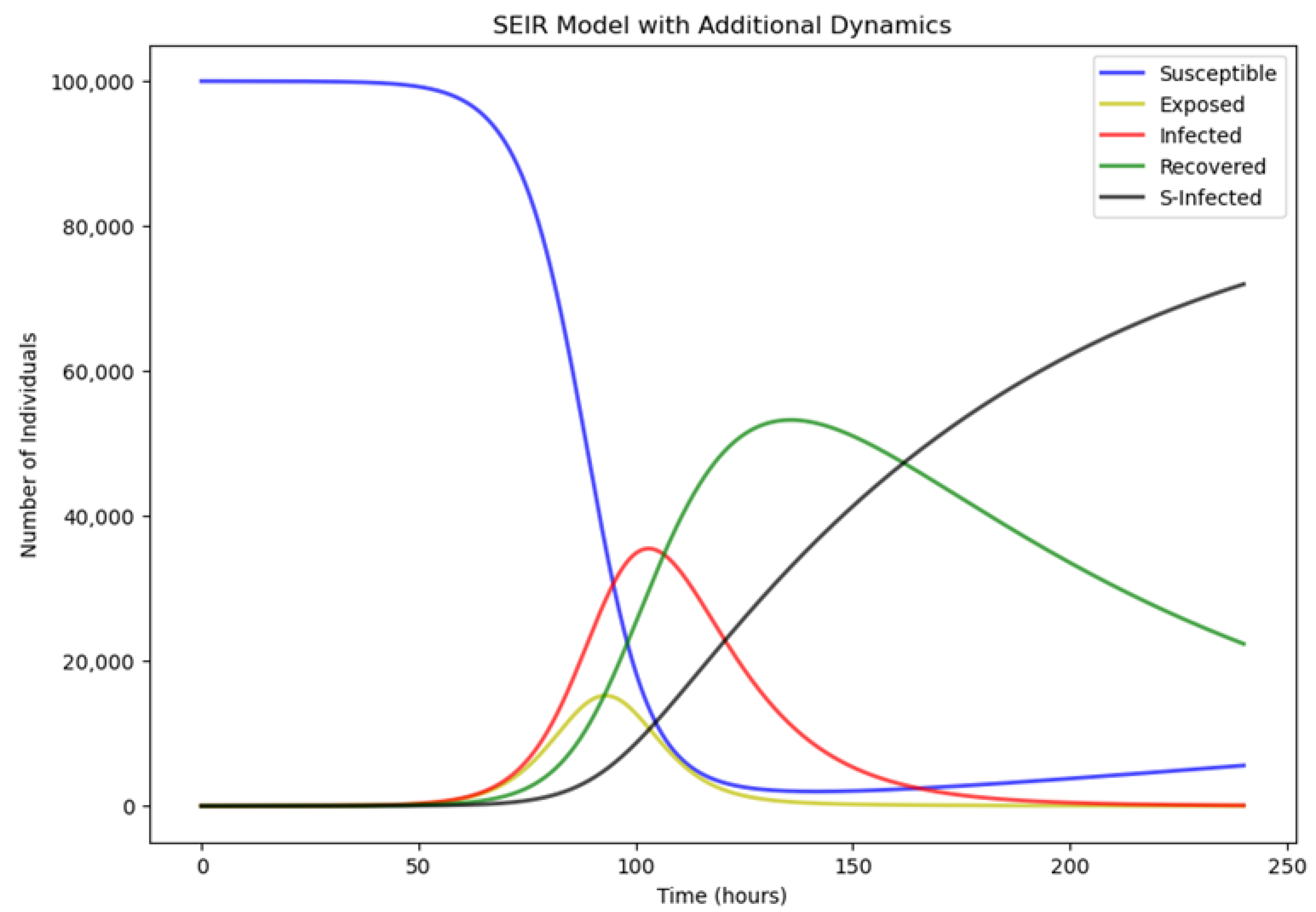

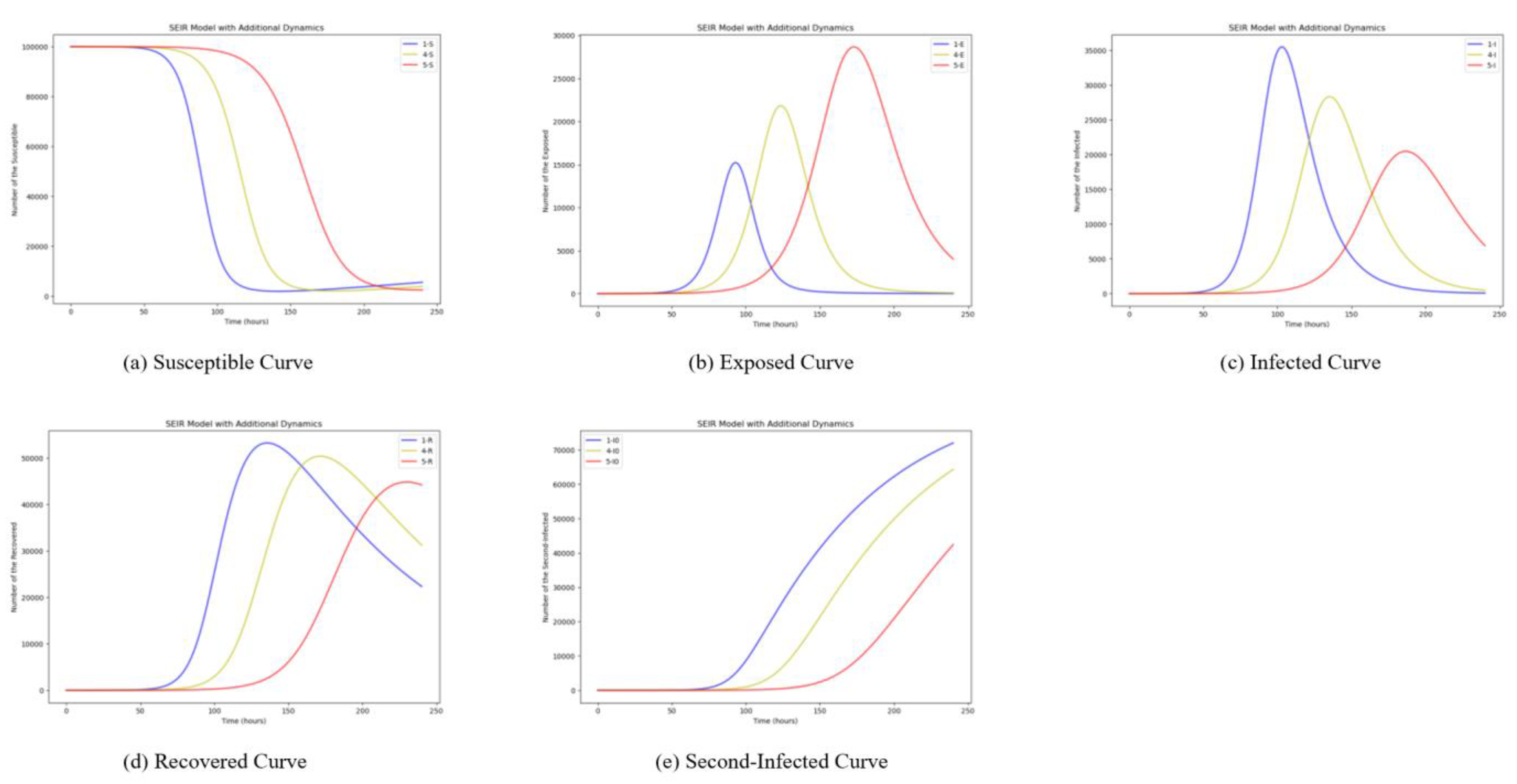
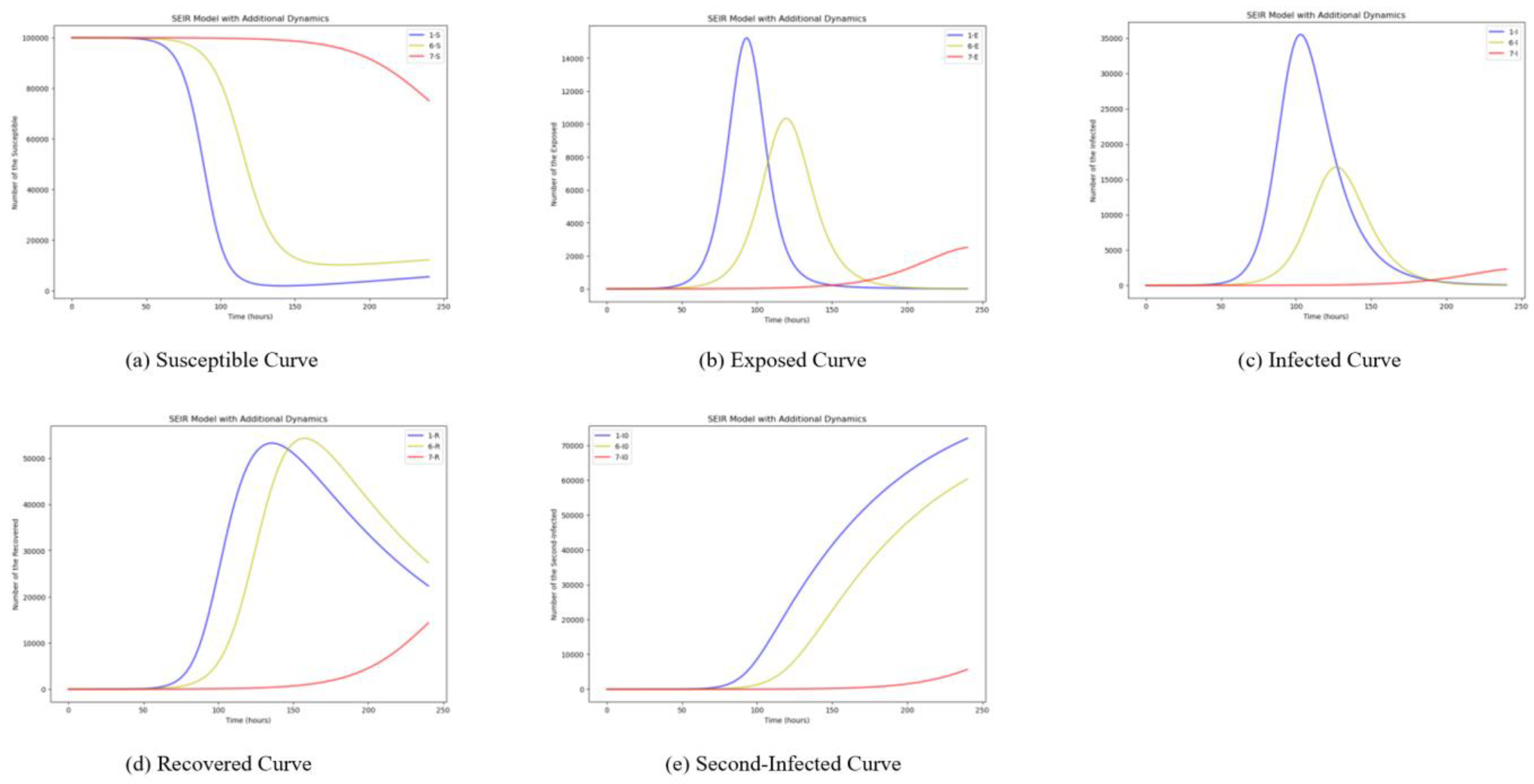


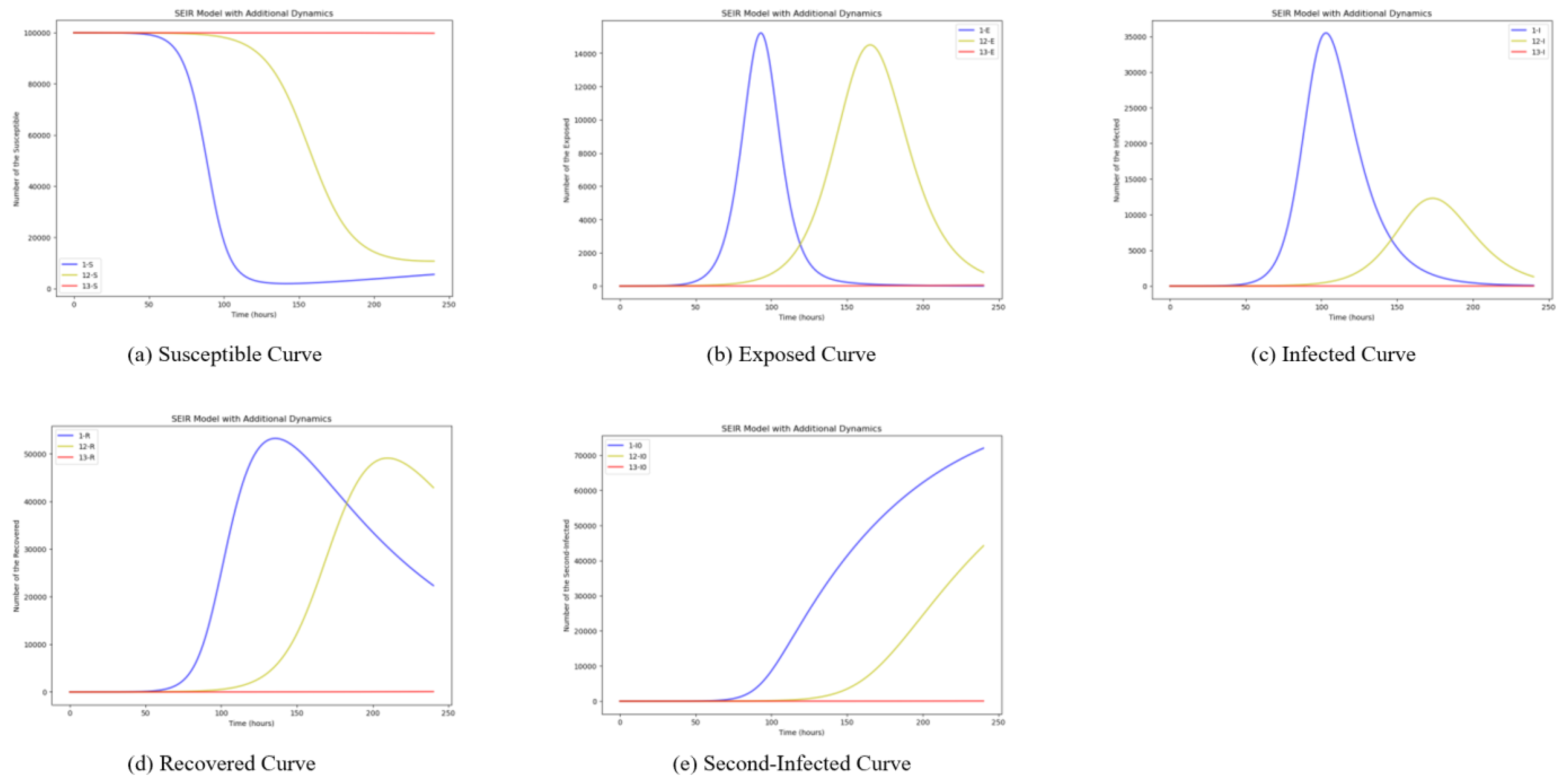
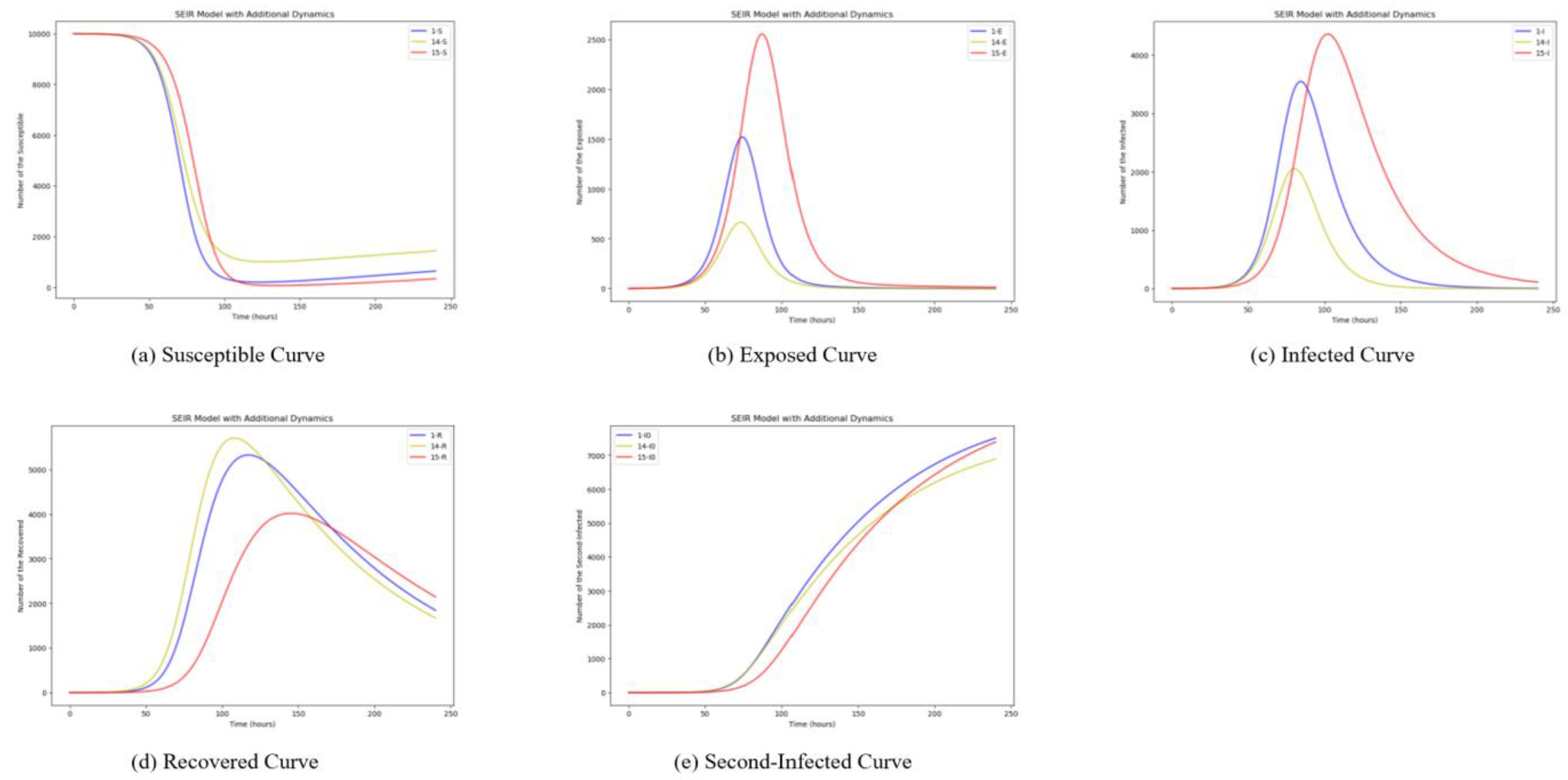
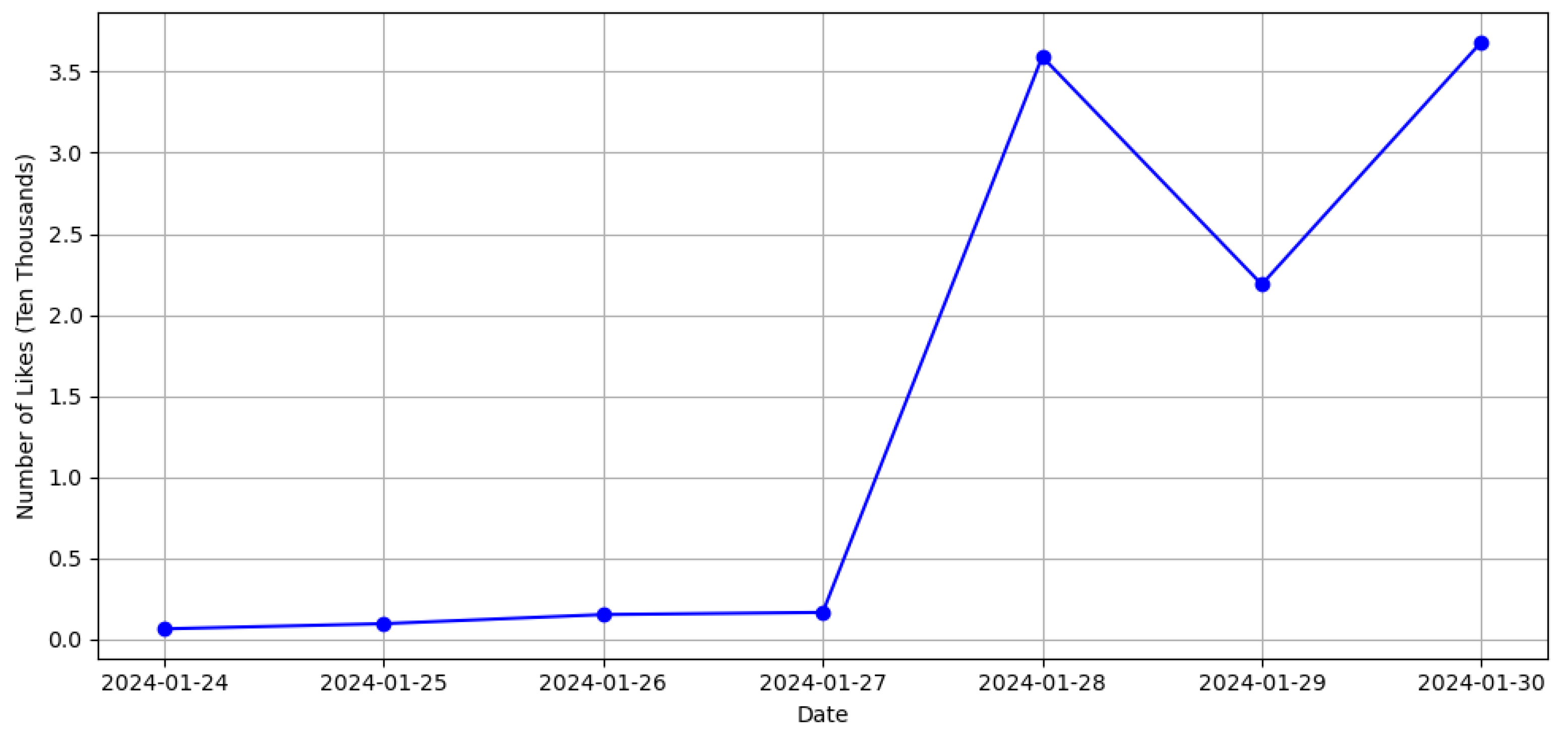


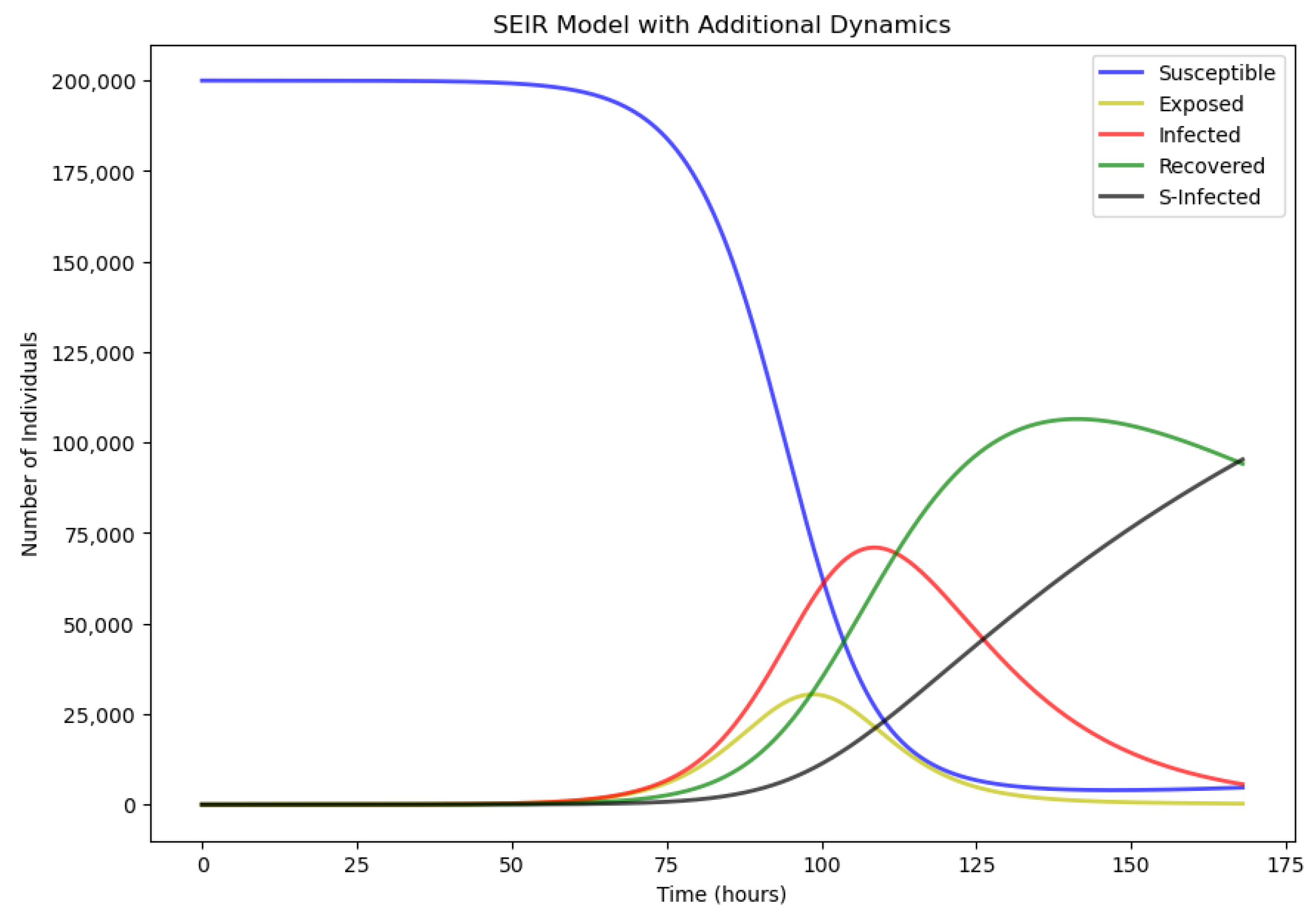
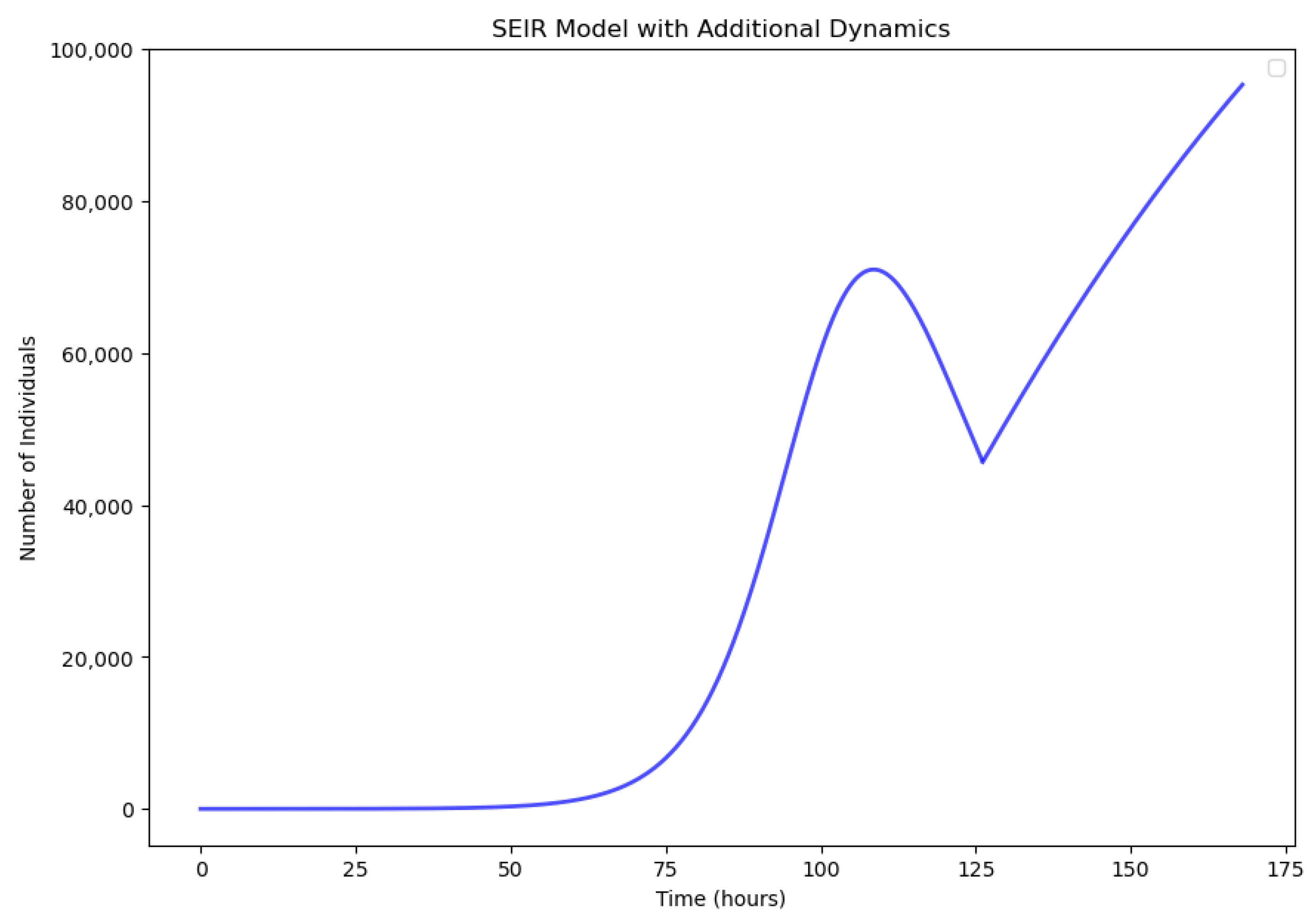
| SEIR Model | Concept in Destination Brand Diffusion in Social Media |
|---|---|
| S (susceptible) | Susceptible individuals who pay close attention to destination branding events in large numbers. |
| E (exposed) | Lurkers who are interested in a destination hot event but are neutral about it and waiting to see what will happen. |
| I (infected) | Communicators who are aware of hot events in the destination and then communicate the information on the social media platform. |
| R (recovered) | Movers who have lost interest in destination hot events and no longer participate in communications. |
| I0 (secondarily infected) | Communicators who are re-informed about hot events in the destination and then spread the information for a second time. |
| Project | |||||
|---|---|---|---|---|---|
| 1 | 0.3 | 0.2 | 0.05 | 0.01 | 0.0005 |
| 2 | 0.15 | 0.2 | 0.05 | 0.01 | 0.0005 |
| 3 | 0.6 | 0.2 | 0.05 | 0.01 | 0.0005 |
| 4 | 0.3 | 0.1 | 0.05 | 0.01 | 0.0005 |
| 5 | 0.3 | 0.05 | 0.05 | 0.01 | 0.0005 |
| 6 | 0.3 | 0.2 | 0.1 | 0.01 | 0.0005 |
| 7 | 0.3 | 0.2 | 0.2 | 0.01 | 0.0005 |
| 8 | 0.3 | 0.2 | 0.05 | 0.001 | 0.0005 |
| 9 | 0.3 | 0.2 | 0.05 | 0.1 | 0.0005 |
| 10 | 0.3 | 0.2 | 0.05 | 0.01 | 0.005 |
| 11 | 0.3 | 0.2 | 0.05 | 0.01 | 0.05 |
| 12 | 0.3 | 0.1 | 0.1 | 0.01 | 0.0005 |
| 13 | 0.3 | 0.05 | 0.2 | 0.01 | 0.0005 |
| 14 | 0.3 | 0.4 | 0.1 | 0.01 | 0.0005 |
| 15 | 0.3 | 0.1 | 0.025 | 0.01 | 0.0005 |
Disclaimer/Publisher’s Note: The statements, opinions and data contained in all publications are solely those of the individual author(s) and contributor(s) and not of MDPI and/or the editor(s). MDPI and/or the editor(s) disclaim responsibility for any injury to people or property resulting from any ideas, methods, instructions or products referred to in the content. |
© 2024 by the authors. Licensee MDPI, Basel, Switzerland. This article is an open access article distributed under the terms and conditions of the Creative Commons Attribution (CC BY) license (https://creativecommons.org/licenses/by/4.0/).
Share and Cite
Deng, L.; Tan, J.; He, D.; Zhao, H.; Wang, Z. Dynamic Mechanism of Destination Brand Diffusion: Agent-Based Modeling and Simulation. Systems 2024, 12, 124. https://doi.org/10.3390/systems12040124
Deng L, Tan J, He D, Zhao H, Wang Z. Dynamic Mechanism of Destination Brand Diffusion: Agent-Based Modeling and Simulation. Systems. 2024; 12(4):124. https://doi.org/10.3390/systems12040124
Chicago/Turabian StyleDeng, Lihui, Jin Tan, Danyang He, Hong Zhao, and Zongshui Wang. 2024. "Dynamic Mechanism of Destination Brand Diffusion: Agent-Based Modeling and Simulation" Systems 12, no. 4: 124. https://doi.org/10.3390/systems12040124
APA StyleDeng, L., Tan, J., He, D., Zhao, H., & Wang, Z. (2024). Dynamic Mechanism of Destination Brand Diffusion: Agent-Based Modeling and Simulation. Systems, 12(4), 124. https://doi.org/10.3390/systems12040124





